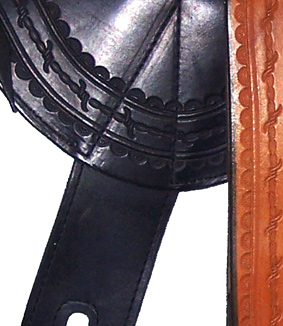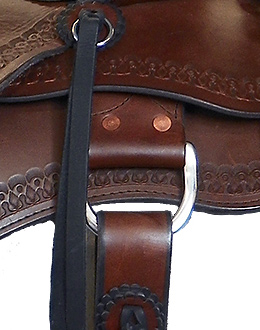Here are ten tack care tips to keep in mind. Being from Wyoming we’re aware that the folks who live in the northern half of the United States don’t get much of an opportunity to horseback ride during the winter months. With the arrival of more hospitable riding weather, now is the time to take a closer look at your tack to see what kind of shape it’s in. Tack care should be part of your routine.
It is said that there are two types of people when it comes to tack care. The first group feels that tack is just another tool; the other group treasures theirs and wants to take the best possible care of it. Each group is fairly easy to identify. With the former you’ll find their saddles and tack laying around outside or in the back of a pick-up truck completely exposed to the weather and the sun. With the latter you often find their saddle and tack proudly on display in the entry way to their home.
 Check for any wear and tear that might need to be addressed now by checking the saddle rigging. On English saddles take a look at where the billets are sewn to the saddle. Make sure that the leather is not worn and that the stitching isn’t frayed.
Check for any wear and tear that might need to be addressed now by checking the saddle rigging. On English saddles take a look at where the billets are sewn to the saddle. Make sure that the leather is not worn and that the stitching isn’t frayed.- Check that the holes that the girth buckles go through haven’t stretched to the point where they might rip.
- Horse sweat is one of the worse enemies of saddle leather. The salt in dried sweat absorbs the natural oils in leather. Eventually, if left there it will first dry the leather out and then the leather will start to split or form cracks. Make sure your saddle leather is not dry and cracking; if it is, clean and oil the leather to make it supple again.
 On Western rigged saddles, first check the area around the rigging plate. Look over the leather for dryness and cracking. Check the rivets that attach the plate to the leather. Make sure they haven’t stretched the leather and pulled loose.
On Western rigged saddles, first check the area around the rigging plate. Look over the leather for dryness and cracking. Check the rivets that attach the plate to the leather. Make sure they haven’t stretched the leather and pulled loose.- Check your latigo and offside billet for wear, drying and cracking.
- The next area to really focus in on is the stirrup leather or fenders. On English saddles check the stitching that attaches the buckle to the leather. Make sure it isn’t worn and fraying.
- Check all the holes to make sure they’re in good shape and not about to rip. Once again, check over the entire strap for dryness and cracking.
- On Western fenders, check the rivets that attach the Blevins buckle to the strap. Make sure they haven’t stretched the leather and might pull loose.
- Check the area where the fender is attached to the strap. Look over any rivets or stitching for wear. It’s much better to take care of a problem now rather than have a failure on the trail.
- Periodically cleaning, oiling and conditioning of all of your leather goods and tack will dramatically extend their life.


Comments 2
are you still recommending BICK 4
Author
Yes, we still use it all the time!